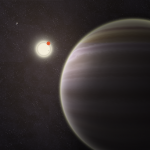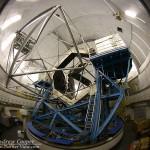Kepler’s follow-up observers confirm new discoveries
More than 2,300 exoplanet candidate discoveries have made it the most prolific planet hunter in history. But even NASA’s Kepler mission needs a little help from its friends.

A single Kepler observation alone is often not enough to prove that the telescope has found an exoplanet, said Nick Gautier, the mission’s deputy project scientist at NASA’s Jet Propulsion Laboratory, Pasadena, Calif., who coordinated and continues to help run Kepler’s robust follow-up program.
Kepler finds exoplanets by watching for worlds that move directly between the telescope and their host stars. As they do this, they block a tiny fraction of the star’s light, an event astronomers call a “transit.”
“A Jupiter-size planet orbiting a sun-size star would block only one percent of its light,” Gautier said. “An Earth-size planet would block much, much less.”
“Just seeing a transit signal doesn’t give us a high degree of confidence that what we’re actually seeing is a planet,” Gautier explained. “We might be seeing one star in a binary system move in front of another, or the light from a background binary star might make the same light curve as a transiting exoplanet.”
Not only are these fluctuations in light incredibly tiny, but other kinds of cosmological events can look very much like transits to Kepler’s camera. Astronomers need to be very careful to weed out these false alarms. The Kepler data are initially processed by a sophisticated program called the “pipeline,” which weeds out transits that are obviously not exoplanets, but astronomers need to get hands-on with the Kepler data to meet the very strict criteria for what qualifies as a “confirmed” exoplanet.
One of the most common false alarms is caused by what are called “eclipsing binaries” — two stars that orbit and pass in front of each other. “If one of the stars is smaller and dimmer than the other, it can create a light curve that looks a lot like a planet,” Gautier said. A similar result can be produced when a background star is spatially close to the target star and Kepler can’t tell the difference between the light of the two.

NASA’s Spitzer Space Telescope, which observes exoplanet atmospheres, has also been employed to separate real planet finds from eclipsing binary stars.
“Because Spitzer can look at planets in the infrared, we can tell if the object that’s moving in front of the star is cool enough to be a planet and not another star,” Gautier said. Spitzer’s ability to determine the color and shape of the transit signal helps the Kepler science team separate real planets from the false alarms.
Sometimes, close analysis of Kepler’s findings can lead to plenty of clues hidden in the data. When multiple planets orbit a star, their gravities interact and the planets tug on each other. These forces cause tiny variations in the speed of each planet’s orbit, and when these planets transit their stars, Kepler can observe the variations in timing for each transit. Such Transit Timing Variations can give astronomers enough information to know, with a high degree of confidence, that they are looking at real exoplanets.
Once a Kepler planet candidate completes the gauntlet of follow-up observations, Gautier and the Kepler science team pass it through one final test. Developed by astronomers at Harvard University, Cambridge, Mass., the “Blender” program combines all the known information about a particular exoplanet candidate: light curve data, measurements from ground telescopes, and Spitzer data, with the currently estimated numbers of exoplanets and binary stars in the galaxy. Using these data, Blender outputs a probability that a Kepler candidate is, in fact, an actual planet.
“If Blender determines that it’s 99.9 percent probable that a candidate is a real planet, then we’re pretty confident at that point to call it a confirmed discovery,” Gautier said. “And the more data we collect for each candidate, the more we can increase that probability.”
The increasing amount of Kepler data means that some very intriguing discoveries may lie in Kepler’s future, including, perhaps, many more small, Earth-size exoplanets. “We keep bootstrapping down to smaller and smaller planets and better and better probabilities as we collect data and refine the follow-up process,” Gautier said. “I expect that the pace of new, confirmed Kepler discoveries is just going to continue increasing.”
More information on the Kepler mission is online at: http://www.nasa.gov/kepler. More information on the Spitzer mission is at: http://www.spitzer.caltech.edu. More information on NASA’s planet-hunting missions is online at: http://planetquest.jpl.nasa.gov/.

